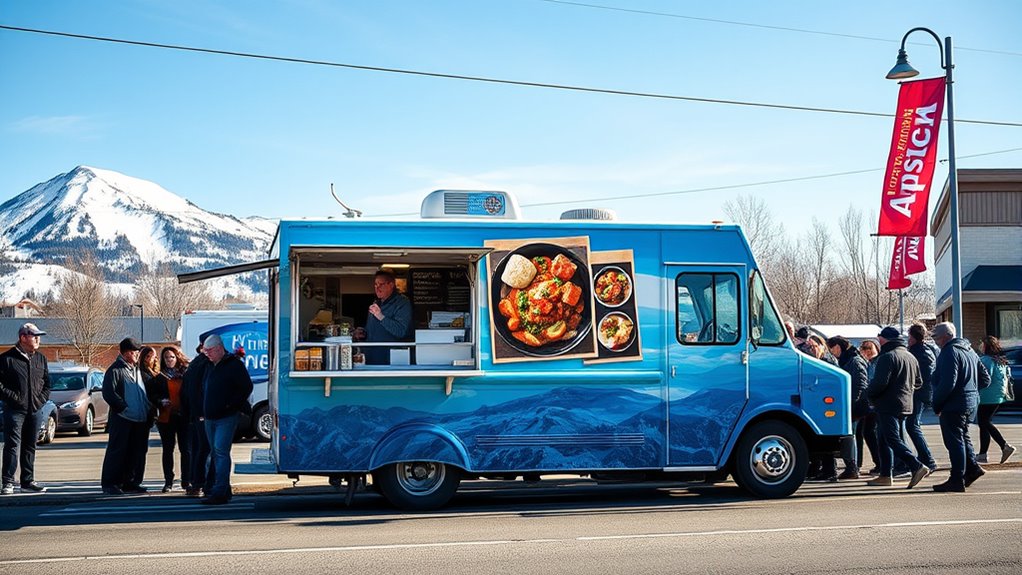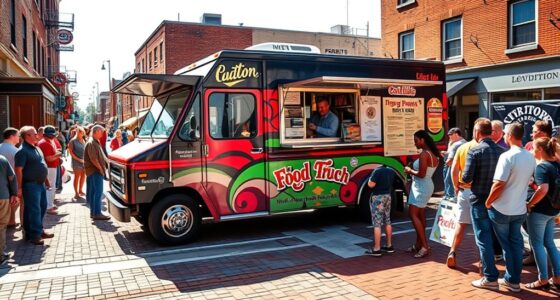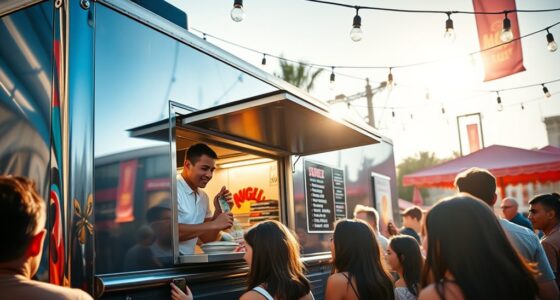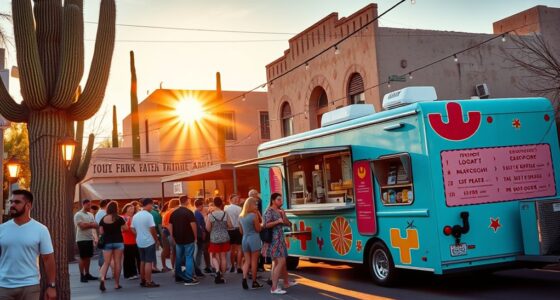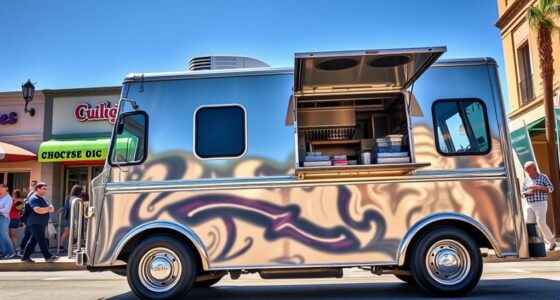To open a food truck in Anchorage, you’ll need to obtain permits from the local health department and comply with municipal codes, including sanitation and signage rules. Expect startup costs between $40,000 and $120,000, covering vehicle, equipment, and licensing expenses. Find approved, mobile-friendly locations and develop a safe, appealing menu that meets health standards. For effective marketing, leverage social media platforms to attract fresh customers. Keep exploring to discover detailed steps to launch your food truck with success.
Key Takeaways
- Obtain necessary permits and licenses from Anchorage health department and state agencies, including vehicle registration and food establishment permits.
- Budget $40,000–$120,000 for vehicle costs, outfitting, inventory, permits, insurance, and marketing expenses.
- Ensure operations at approved sites with proper permits, and maintain mobility unless using a self-contained unit.
- Develop a compliant menu focusing on simple, pre-packaged ingredients and proper temperature controls, with certified staff.
- Promote your food truck via social media platforms, sharing specials, customer feedback, and location updates to attract target audiences.
Navigating Permits and Licensing Requirements
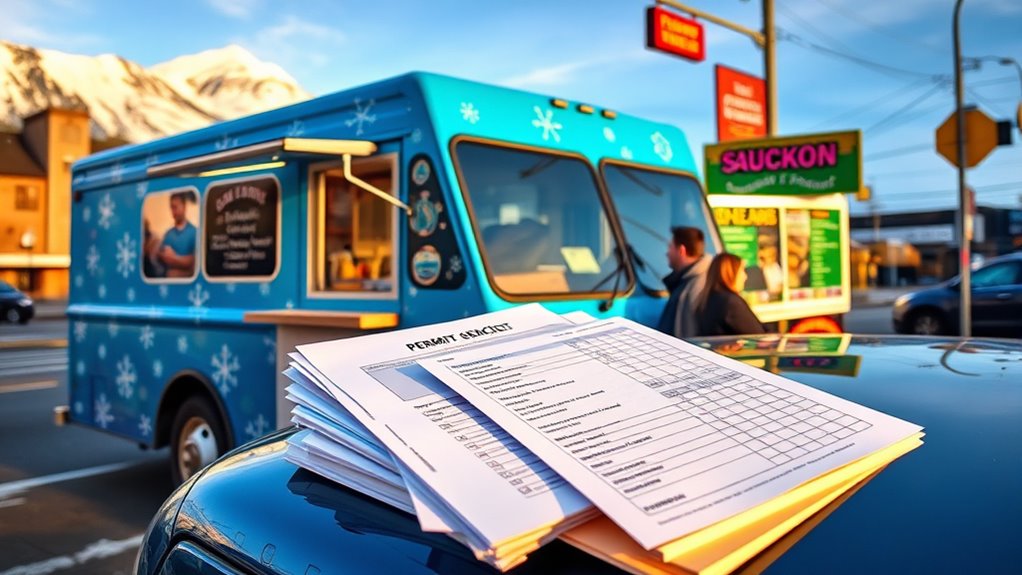
Steering permits and licensing requirements for a food truck in Anchorage can seem complex, but understanding the key steps makes the process manageable. First, your mobile food unit must comply with Anchorage Food Code (AMC 16.60) and municipal rules. Mobile units include vehicles or trailers with food service capabilities, which need to be titled and licensed as motor vehicles or trailers through the State of Alaska. If your unit becomes immobile or connects to water and sewer lines, it loses mobile status. You’ll also need a dedicated hand sink and other sanitation features. Before opening, you must obtain a Food Worker Card by passing an online test and secure a food establishment permit from the Anchorage Food Safety and Sanitation Program. The process involves submitting detailed plans for review and approval by multiple agencies. Additionally, all food trucks must adhere to specific signage and labeling regulations, including display of permits and proper food labeling, to ensure compliance with local health standards. It is also important to stay informed about permitting procedures, which may include inspection and approval from the local health department, to maintain ongoing compliance.
Understanding the Costs Involved
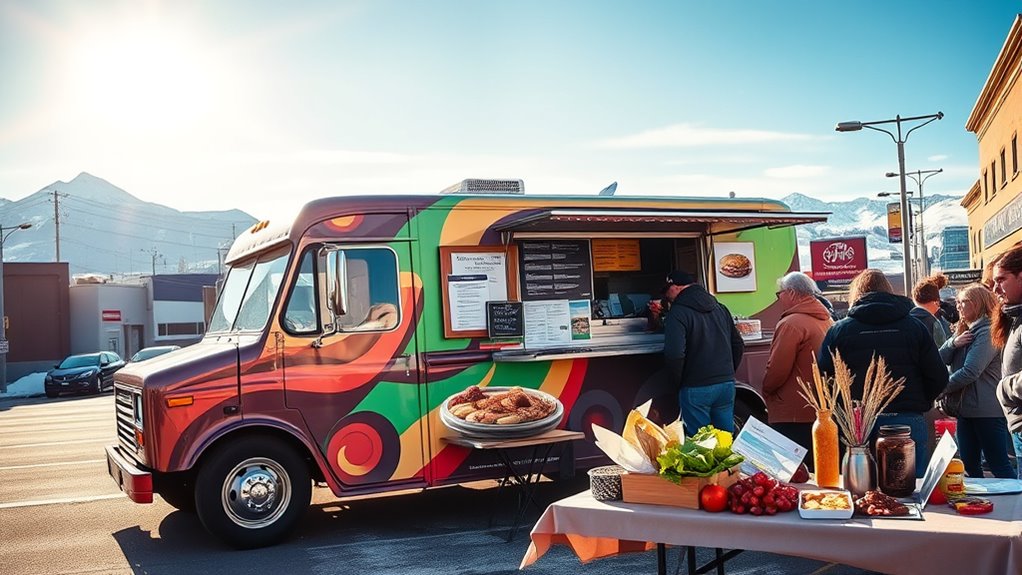
Understanding the costs involved is a key step in planning your food truck business in Anchorage. The initial investment for a vehicle ranges from $40,000 to $120,000, depending on condition and outfitting, with coffee trucks costing between $15,000 and $100,000. Outfitting, including kitchen equipment and plumbing, can add considerably to startup expenses. Expect inventory costs around $3,000 to $5,000, plus approximately $300 for serveware and utensils. Licensing and permits typically cost $500 to $1,500 annually, with some fees doubling during plan reviews. Insurance premiums range from $2,000 to $4,000 per year, covering liability and vehicle protection. Operational costs, including fuel, maintenance, and labor, average $500 to $1,000 monthly. Marketing budgets generally start at $3,000 to $8,000 to build your brand and attract customers. Additionally, local regulations and zoning laws can influence overall costs and operational considerations. Being aware of tableware materials and their costs can also help in budgeting for serveware and ensuring compliance with health standards.
Securing Approved Locations and Operations
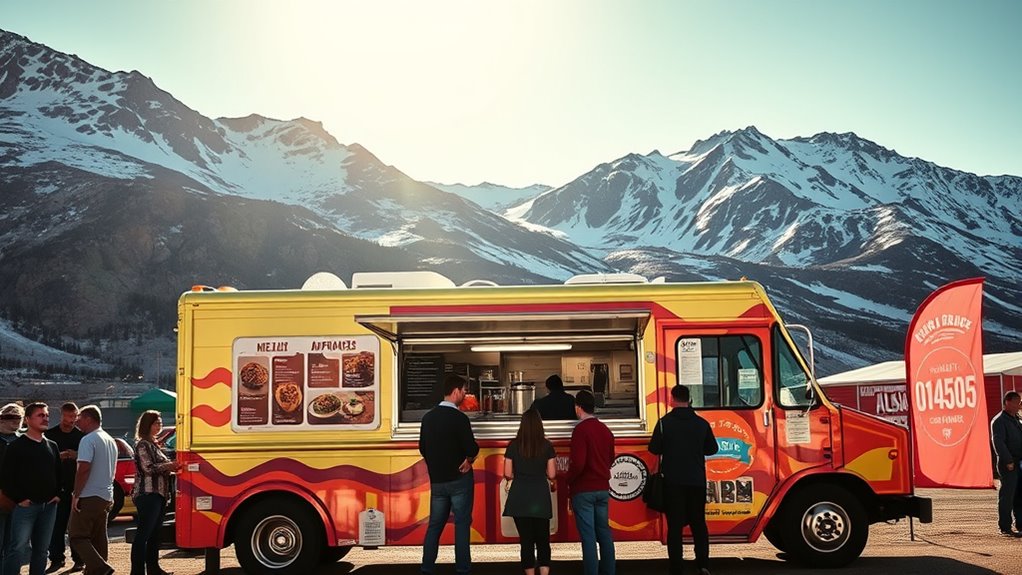
Securing approved locations is essential for operating your food truck legally and successfully in Anchorage. You must operate from sites that meet municipal codes, including approved commissaries or facilities unless your unit is self-contained. Locations must comply with the Anchorage Food Code (AMC 16.60) for food safety and sanitation. You’ll need permits for permanent or semi-permanent sites, and mobile units must remain mobile, avoiding permanent water or sewer connections. Inspections are required before and during operation to ensure safety standards. Additionally, obtain a food establishment permit and any event-specific permits if vending at festivals or private events. Coordinating with municipal departments guarantees your chosen locations are compliant and permits are in place. Properly tuning your equipment and ensuring your vehicle meets local standards can also prevent delays in your licensing process.
Developing a Safe and Marketable Menu
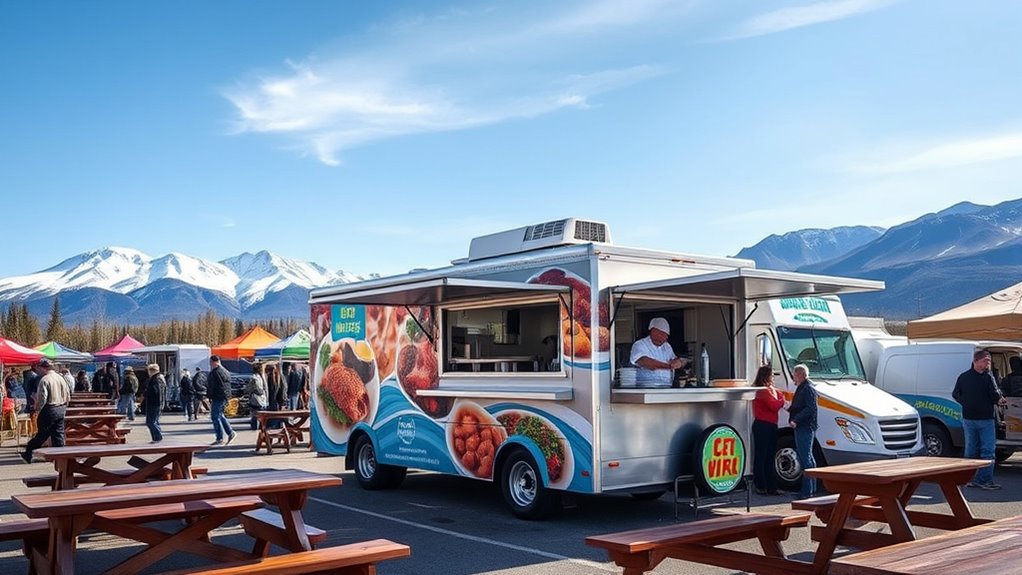
Creating a menu that is both safe and appealing starts with careful planning to meet regulatory standards and fit the unique constraints of a mobile food operation. You need to guarantee your menu complies with Alaska’s health codes and mobile unit regulations. In Alaska, regulations often emphasize the importance of using approved commissary kitchens to ensure proper storage, preparation, and disposal practices. Incorporating authentic materials and emphasizing quality in your ingredients can also help attract customers and boost sales. 1. Choose simple, easily prepared items that don’t require complex processes like smoking or curing unless you have approved HACCP plans. Pre-packaged ingredients can help reduce contamination and preparation time. 2. Prioritize menu items that minimize hazardous food handling and maintain strict temperature controls with appropriate equipment. 3. Employ certified personnel, including a Food Protection Manager, to oversee safe food prep, and train staff regularly to prevent cross-contamination and foodborne illnesses.
Designing a safe, compliant menu tailored for Alaska’s mobile food regulations ensures success and customer trust.
This approach ensures your menu is safe, compliant, and marketable for Anchorage’s busy food truck scene.
Implementing Effective Marketing Strategies

Implementing effective marketing strategies is essential for standing out in Anchorage’s competitive food truck scene. To maximize visibility, post frequently on Instagram, Facebook, and Snapchat, sharing daily specials, location updates, and local landmarks. Use videos of customer feedback to build trust and authenticity. Tease upcoming spots to generate excitement and community buzz. Tailor content for millennials and Gen Z by focusing on variety and sustainability, using targeted hashtags for better SEO. Cross-promote menu items and events through stories to highlight exclusivity. Incorporate affiliate disclosure practices by sharing special promotions or collaborations to enhance credibility and trust with your audience.
Ensuring Health and Safety Compliance

To operate legally and safely in Anchorage, your food truck must meet specific health and safety regulations. Guarantee compliance protects public health and keeps your business in good standing. Here are key steps to follow:
- Obtain the necessary licenses, including registering your vehicle with the state and operating out of an approved commissary unless fully self-contained.
- Maintain proper hygiene by having dedicated handwashing sinks, and ensure employees follow strict sanitation protocols, including frequent handwashing and health checks.
- Pass periodic inspections by the Anchorage Food Safety and Sanitation Program, submitting all required documents like business licenses and food safety certificates, and passing an opening inspection before serving customers.
- Food safety manager certification is often required for supervisory staff to ensure compliance with health standards, and obtaining this certification demonstrates your commitment to maintaining a safe food environment.
- Staying informed about food safety standards and updates helps ensure your operations remain compliant with local regulations and best practices.
Following these guidelines keeps your food truck compliant and your customers safe.
Frequently Asked Questions
How Long Does the Permit Approval Process Typically Take in Anchorage?
The permit approval process in Anchorage typically takes about 30 days. You need to submit a complete plan review packet at least 30 days before opening or any changes. The department reviews your plans and application, providing written notices for any issues. Delays happen if plans are incomplete or non-compliant. After approval, scheduling a preopening inspection adds a few extra days before you can start operations smoothly.
Are There Specific Zoning Restrictions for Mobile Food Units in Anchorage?
You need to know that Anchorage has specific zoning restrictions for mobile food units. You must operate in designated commercial or mixed-use zones and avoid residential areas. You can’t vend within 50 feet of intersections or block fire lanes, and your location must pass zoning and traffic approvals. Also, parking spaces used by your truck shouldn’t reduce parking for other businesses, and fire safety codes must be strictly followed.
Can I Operate a Food Truck Without a Commissary in Anchorage?
You can operate a food truck without a commissary in Anchorage if your unit is fully self-contained, meaning it has its own water, wastewater, and handwashing facilities. However, if you’re not self-sufficient or preparing food on-site, you’ll likely need to use an approved commissary. Always check with Anchorage’s Food Safety and Sanitation Program to confirm whether your truck qualifies for this exemption and meets all local requirements.
What Are Common Mistakes to Avoid During the Application Process?
When applying for your mobile food business, you need to avoid common mistakes like submitting incomplete or inaccurate paperwork, which delays approval. Don’t overlook specific municipal requirements, such as food safety plans or vehicle registration. Be sure to clearly outline your location and menu plans, and make certain your application aligns with local zoning and health standards. Properly budgeting for permits, inspections, and compliance costs prevents surprises and keeps your process smooth.
How Often Do Health Inspections Occur for Food Trucks in Anchorage?
You might be surprised to learn food trucks in Anchorage face inspections as needed, with no set schedule. While fire safety inspections happen every two years, health inspections are more flexible, depending on complaints or observed violations. You must grant access anytime inspectors arrive to verify sanitation and safety standards. Staying compliant means being prepared for inspections at any moment, ensuring your truck remains open and operational without penalties.
Conclusion
Starting your food truck in Anchorage means turning your dream into reality amid the mountain vistas and coastal breezes. With permits secured, a vibrant menu, and strategic marketing, you’ll roar to life on bustling streets. Picture yourself serving warm, savory bites to enthusiastic customers as the northern lights dance overhead. Embrace the adventure, stay compliant, and watch your food truck become a beloved fixture in Anchorage’s lively scene—your journey from concept to community is just beginning.
